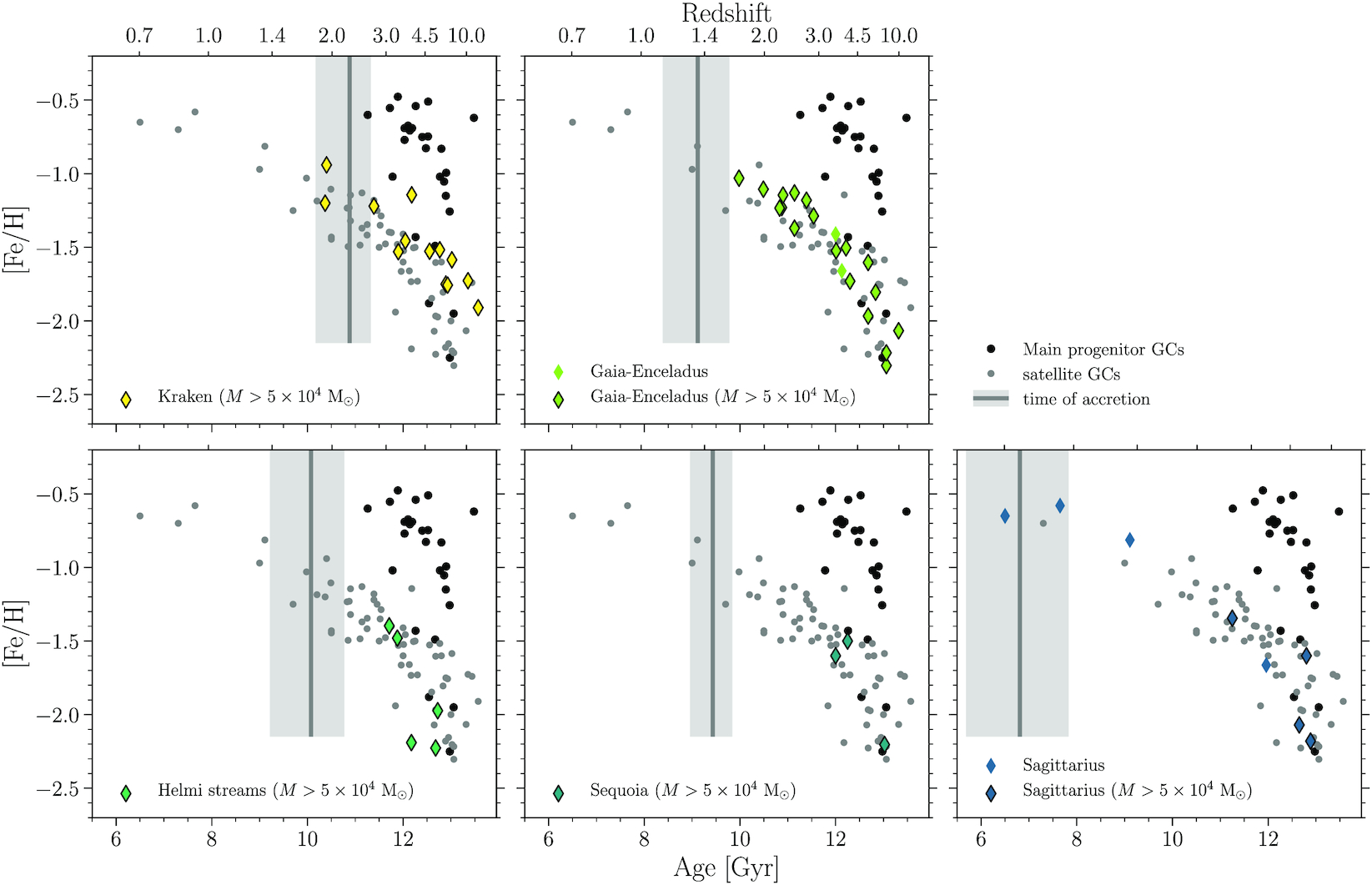Authors: J. M. Diederik Kruijssen, Joel L. Pfeffer, Mélanie Chevance, Ana Bonaca, Sebastian Trujillo-Gomez, Nate Bastian, Marta Reina-Campos, Robert A. Crain, and Meghan E. Hughes
First Author’s Institution: Astronomisches Rechen-Institut, Zentrum fur Astronomie der Universitat Heidelberg
Status: Published in MNRAS [open access]
What archaeology?
Just like archaeologists can trace the migration and assimilation of people in past societies, astronomers can reconstruct the assembly history of the Galaxy that we live in. In standard galaxy formation theory, galaxies like our Milky Way formed through the hierarchical merging of many smaller galaxies. According to this picture, some of the stars and star clusters in our Galaxy were not originally born here, but are “immigrants” that were brought into the Milky Way when their parent galaxy entered. Galactic archaeologists are developing techniques to trace back the origin of these galactic immigrants and reconstruct properties of the accreted galaxies. One avenue is through the stars that were left behind in a stream (see this Astrobite), but today’s authors study where the star clusters in our galaxy come from.
Why star clusters?
Globular clusters consist of hundreds of thousands of tightly bound stars, and they are both ancient (billions of years old) and stable. When a satellite galaxy is accreted into the Milky Way, its globular clusters are likely to survive and migrate as a whole. This makes globular clusters excellent fossil records, because they preserve the metallicity of the environment in which they formed and carry this signature wherever they travel.
Astronomers can identify accreted globular clusters based on their age and metallicity. Figure 1, taken from today’s paper, shows the observed age-metallicity relation for Milky Way globular clusters. The globular clusters on the “main progenitor” branch are clearly separated from those accreted from various satellite galaxies. The main progenitor of the Milky Way contains all the “native” stars and globular clusters that were not from satellite galaxies.

Figure 1. The age-metallicity distribution of Galactic globular clusters. In all panels, black points indicate globular clusters that formed in the “Main progenitor” while colored diamonds indicate globular clusters from each accreted satellite galaxy. The vertical line represents the inferred accretion time. Reproduced from Fig 3 in the paper.
Artificial neural network
The data points in Figure 1 only contain the observed properties of globular clusters, and there is no obvious connection to the satellite accretion events. To bridge this gap, the authors in today’s paper make use of galaxy formation simulations. The E-MOSAICS simulations follow the co-formation and co-evolution of galaxies and their globular clusters, providing the crucial link between accretion history and globular cluster properties.
The authors train an artificial neural network to infer the progenitor galaxy that brought in a group of globular clusters. Specifically, the input parameters are the median and interquartile ranges (IQRs) of the globular cluster orbital radii, eccentricities, ages, and metallicities, and the networks can predict the accretion time and the galaxy stellar mass. The resulting neural network is applied to the globular clusters shown in Figure 1 and gives the accretion times as outputs.
Accretion history of the Milky Way
After applying the artificial neural network, the reconstructed formation history of the Milky Way is shown in Figure 2. This figure is called a galaxy merger tree because each branch (black and grey lines) represents one accreted satellite galaxy, and the branches are ordered by their accretion times. Kraken was the first galaxy to be accreted, followed by the progenitor of the Helmi streams, Sequoia and Gaia-Enceladus, and finally Sagittarius.

Figure 2. Galaxy merger tree of the Milky Way. The main progenitor is denoted by the trunk of the tree, coloured by stellar mass. Black lines indicate the five identified (and likely most massive) satellites, with the shaded areas visualizing the probability distributions of the accretion times. The coloured circles indicate the stellar masses of the satellite galaxies at the time of accretion. The annotations list the minimum number of GCs brought in by each satellite. From left to right, the six images along the top of the figure indicate the identified progenitors, i.e. Sagittarius, Sequoia, Kraken, the Milky Way’s Main progenitor, the progenitor of the Helmi streams, and Gaia-Enceladus. Reproduced from Fig 9 in the paper.
The “main progenitor” of the Milky Way is the trunk of the tree, and it grows in stellar mass each time it accretes a new galaxy. The thickness of the lines indicate the mass ratio of the accreted galaxy versus the main progenitor. As you can imagine, the more massive a satellite is, the more damage it causes when it combines with the Milky Way. In a minor merger (defined by mass ratios smaller than 1:4), the satellite is small enough for the Milky Way to comfortably absorb; however, in major mergers (where the two galaxies have comparable mass), both galaxies will be significantly disturbed and the Milky Way disk can even be destroyed. Luckily, the Milky Way never experienced a major merger according to the authors of today’s paper. Among the minor mergers, Kraken was the most significant merging event that the Milky Way experienced, since it has the highest mass ratio at the time of accretion.
The authors tally up the total contribution of stellar mass and globular clusters from the accreted satellites. They find that only a few percent of the stellar mass and about 35-50% of globular clusters in the Milky Way were accreted. The rest formed inside the Milky Way. They conclude that the Milky Way had an unusually quiet formation history.
Today’s paper uses globular clusters and artificial neural networks to reconstruct a detailed accretion history of our Galaxy. No Indiana Jones required for galactic archaeology!
Astrobite edited by Roan Haggar
Featured image credit: Diederik Kruijssen
"machine" - Google News
May 04, 2021 at 09:01PM
https://ift.tt/2RqZD5P
Reconstructing the Galactic merger history with machine learning - Astrobites
"machine" - Google News
https://ift.tt/2VUJ7uS
https://ift.tt/2SvsFPt
Bagikan Berita Ini















0 Response to "Reconstructing the Galactic merger history with machine learning - Astrobites"
Post a Comment